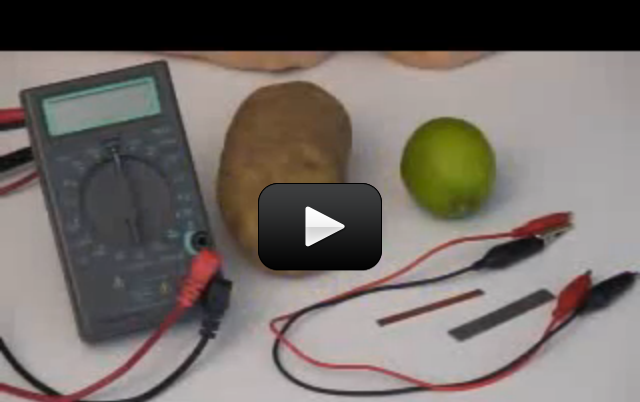This experiment shows how a battery works using electrochemistry. The copper electrons are chemically reacting with the lemon juice, which is a weak acid, to form copper ions (cathode, or positive electrode) and bubbles of hydrogen.
These copper ions interact with the zinc electrode (negative electrode, or anode) to form zinc ions. The difference in electrical charge (potential) on these two plates causes a voltage.
Materials:
- one zinc and copper strip
- two alligator wires
- digital multimeter
- one fresh large lemon or other fruit


Sure, you can use an orange.
Can I use an orange instead of a lemon or lime?
You can try one large paperclip, but be sure that the other electrode is copper.
you said we could use two large paper clips electrically connected together. Can we use one large paper clip that is straightened?
I have Brian’s electronics kit!!!
I love the Experiment!!
The fruits and vegetables don’t have any electricity on their own. But when you insert the copper and zinc strips, the resulting chemical reaction creates an abundance of electrons on one of the strips. That abundance of electrons causes electricity to flow…which can be measured in volts.
does the fruit or vegetable have electricity? ..if it has volts?
Most LEDs require about 2 volts in order to glow. You may need to put more than one “fruit battery” in series in order to reach that voltage.
We got our battery to register on the multimeter, and then we tried connecting it to an LED we had from the electricity unit, but it didn’t light up. Is there not enough voltage to light up an LED?
You definitely want the setting for DC (straight line and dotted line). You’ll want to use the lowest voltage range on your multimeter. We wouldn’t expect to see more than a couple volts. The fact that you see a measurement when your meter is set to 9V tells me that you most likely had a bad connection. Try redoing your connections and then measure again using the lowest voltage setting.
I am having problems. I have a digital multimeter that has 2 settings on the multimeter. V with a wavy line above and a V with a straight and dotted line. One stands for AV and the DC. Neither read any of the vegetables or fruit but when I changed the setting to the 9V setting it started reading it. Am I doing this cprrectly? Thanks
I’ll have my team connect with you right away!
I don’t understand how I do not have access to experiments. I thought if I got the membership, I would have access to the experiments. I would like access to this experiment, please.
hi
oooooooooh thats cool!
Try Radio Shack – they sell them online and ship them to your door.
Cool! I never knew that you could use fresh produce as a battery! I can’t find alligator clips at The Home Depot though, and it will be about a week till we need another trip to Walmart. Do you know if you can get alligator clips at Target though?
Try it and see! (I’ll give you a hint – you need something that has acid inside.)
SUPER COOL !!!!!!!!!!!!!!!!!!!!!!!!!!!!!!!!!!!!!! = ) – Isabel Pitcher, 8 yrs.
Can you use leafy veggies such as cabbage, kale, collard greens, swiss chard etc.??? ~ Jasmin Pitcher, 11 yrs.
The video keeps getting stuck on the same spot.
You can hook up the copper of one lemon to the zinc plate of another, so you’re in effect hooking it up in series (plus to minus). You can use paperclips, although the surface area isn’t a large as a strip. This experiments works better if you use a separate lemon for each set of electrodes when connecting them up together.
How do we hook up more than one to get more power? We aren’t going to buy a digital multimeter. We tried a single christmas light bulb which lights up with a AA battery 1.5 V. How do you hook up more than one fruit or potato? We have copper and zinc sticks from the chemistry set. They can pierce through a few at a time since they are long, but that didn’t work. Do we need separate strips and clips for each fruit?
The easiest places to get zinc and copper are by using a galvanized nail and a copper penny. If you really want the strips, you can order them online: zinc and copper electrodes, or a full set.
Where can I buy: one zinc and copper strip? Thanks.